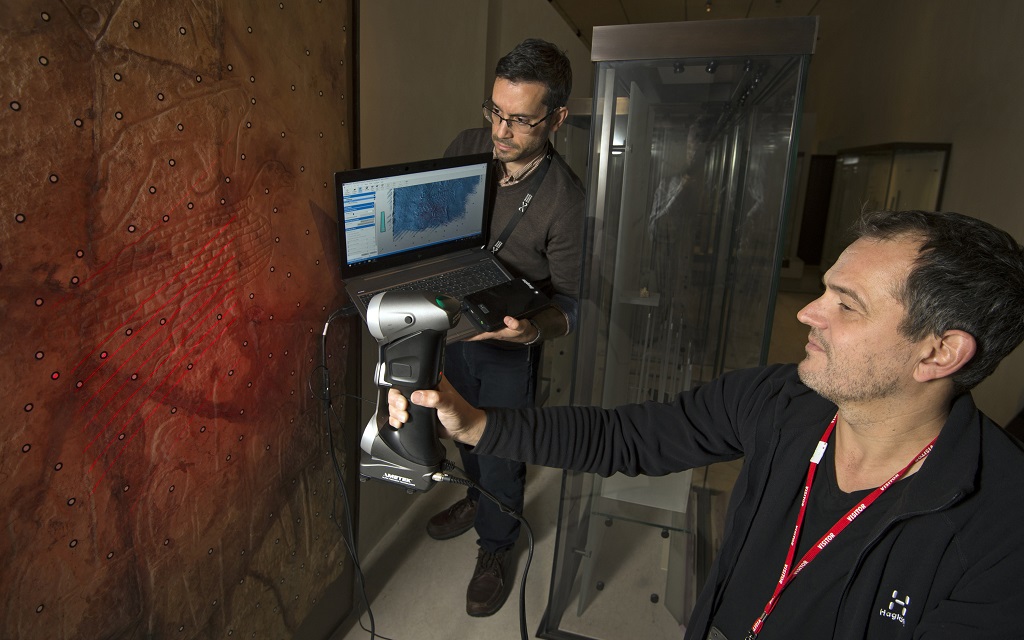
Swedish scientists laser scan Pictish stones in Scotland
A team of Swedish scientists has been visiting Scotland this week to carry out a pioneering new laser scanning technique on carved stones from Orkney and Shetland.
Developed to analyse runestones in Sweden, this is first time the technique has been carried out in Scotland. The pilot project, led by National Museums Scotland and the University of the Highlands and Islands, will focus on two sites: Brough of Birsay, Orkney and Cunningsburgh, Shetland.
These were important early medieval power centres, and seem to have expressed this through monumental inscriptions in stone. They are the only two sites in Europe with evidence for the use of runes, ogham and Pictish symbols.
Dr Adrián Maldonado, Glenmorangie Research Fellow at National Museums Scotland, said: ‘Nothing like this has been attempted in Scotland. Runes are generally studied by those interested in the Viking Age, but we know that ogham was used before and during the period of Scandinavian settlements in Scotland.
‘In fact, we have roughly equal numbers of early medieval inscriptions in both alphabets. The Pictish symbols, a related form of inscribed communication, have rarely been studied alongside these other forms of writing. The answers might help us answer longstanding questions of interactions between Picts, Gaels and Norse.
‘Like the recent discovery of Old English names written on objects from the ‘Viking’ Galloway Hoard, the evidence of inscriptions shows multiple languages and alphabets were in use across early medieval Scotland. This fits into broader research showing the problematic nature of the ethnic labels commonly used, such as Anglo-Saxon, Pictish and Viking, to describe individuals in this period.’

Dr Adrián Maldonado, Glenmorangie Research Fellow, National Museums Scotland and Henrik Zedig ,Länsstyrelsen Västra Götaland, Sweden study a carved stone from the Brough of Birsay on Orkney. (Photo: Neil Hanna)
Dr Alexandra Sanmark, University of the Highlands and Islands, said: ‘The project seeks to trace the establishment of writing as a technology of power in early medieval Britain. Archaeological evidence for literacy includes the Latin alphabet, runes, ogham and Pictish symbols. Scotland is unique for having evidence of all these forms of writing inscribed in stone monuments. This project will focus on sites where multiple writing systems are used.’
New techniques developed by Dr Laila Kitzler Åhfeldt (Swedish National Heritage Board) and Henrik Zedig (Länsstyrelsen Västra Götaland, Sweden) use 3D laser scanning to discern specific methods of runic carving, and even different sculptors according to minute details of carving technique.
This technique has never been applied to Pictish or ogham inscriptions, and it is hoped that it will contribute valuable new information for dating, particularly for damaged inscriptions, and show whether inscriptions across writing systems and languages correspond to different sculptors.
It will feed new data into research supervised by both project directors with outputs expected by 2020, including the ongoing Glenmorangie Research Project, ‘Creating Scotland: Making a Medieval Kingdom AD 800-1200’ (Maldonado) 3D models of the inscribed stones will be made available online and the information will be added to the publicly available National Museums Scotland catalogue.
The project is generously funded by the Society of Antiquaries of Scotland and the Geoffrey Barrow Award.
TAGS

